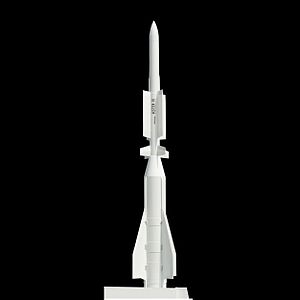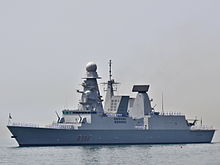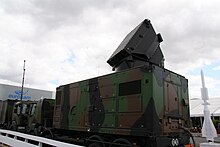avia.wikisort.org - Weapon
The Aster 15 and Aster 30 are a Franco-Italian family of all-weather, vertical launch surface-to-air missiles.[17] The name "Aster" stands for "Aérospatiale Terminale" (French company Aérospatiale having been the project's lead contractor before its missile activities were merged into MBDA). It also takes inspiration from the word "aster" (Greek: ἀστήρ), meaning "star" in Ancient Greek. The missiles as well as the related weapon systems are manufactured by Eurosam, a consortium consisting of MBDA France, MBDA Italy (both with a combined 66% share) and Thales (holding 33%).
| Aster | |
|---|---|
 MBDA Aster 30 on display showing attached booster. | |
| Type | Surface-to-air missile/Anti-ballistic missile |
| Place of origin | France/Italy |
| Service history | |
| In service | 2001–present |
| Used by | See Operators |
| Production history | |
| Manufacturer | Eurosam |
| Specifications | |
| Mass | Aster 15: 310 kg[1] Aster 30: 450 kg[2] |
| Length | Aster 15: 4.2 m[3] Aster 30: 4.9 m[4] |
| Diameter | Aster 15 & 30: 180 mm (7.1 in)[5] |
| Warhead | 15 kg focused fragmented warhead with 2 m lethal radius |
Detonation mechanism | Calculated delay proximity fuze |
| Engine | Solid propellant, two-stage motor[6] |
Operational range | Aster 15: Above 30 km[7] Aster 30: Above 120 km[8] Aster 30 Block 1 NT: Above 150 km[9] Export - Aster 30 (Singapore): Above 70 km[10][11] |
| Flight altitude | Aster 15: 13 km[12] Aster 30: 20 km[13] |
| Maximum speed | Aster 15: Mach 3 (1,000 m/s)[14] Aster 30: Mach 4.5 (1,400 m/s)[15] |
Guidance system | |
Launch platform |
|

The Aster missiles were developed to intercept and destroy the full spectrum of air threats from high-performance combat aircraft, UAVs and helicopters to cruise, anti-radiation and even sea-skimming supersonic anti-ship missiles.[18] In addition, the Aster 30 Block 1 and Block 1 NT were designed to counter ballistic missiles.[19]
The Aster is primarily operated by France, Italy, as well as the United Kingdom as an export customer, and is an integrated component of the PAAMS air defence system (known in the Royal Navy as Sea Viper). As the principal weapon of the PAAMS, the Aster equips the Horizon-class frigates in French and Italian service as well as the British Type 45 destroyers. It also equips the French and Italian FREMM multipurpose frigates, though not through the PAAMS air defense suite itself but specific French and Italian derivatives of the system.
History
During the 1980s, the predominant missiles in Franco-Italian service were short-range systems such as the French Crotale, Italian Selenia Aspide or American Sea Sparrow, with ranges up to a dozen kilometres. Some vessels were also equipped with the American medium/long range RIM-66 Standard. France and Italy decided to start development of a domestic medium/long range surface-to-air missile to enter service in the first decade of the 21st century, that would give them comparable range but superior interception capability to the American Standard or British Sea Dart already in service. Thought was given in particular to the new missile's ability to intercept next-generation supersonic anti-ship missiles, such as the BrahMos missile developed jointly by India and Russia. This allowed the actual systems to have the characteristic of being specialised either in short-to-medium range "point defence" for e.g. ships, or in medium-to-long range "zone defence" of fleets.
In May 1989, a Memorandum of understanding was signed between France and Italy for the development of a family of future surface-to air-missiles. Eurosam was formed shortly afterwards. By July 1995 development had taken shape in the form of the Aster missile and test firing of the first Aster 30 took place. The missile successfully intercepted a target at an altitude of 15,000 m (49,000 ft) and at speeds of 1,000 km/h (620 mph). A Phase 2 contract was awarded in 1997 at US$1 billion for pre-production and development of the French-Italian land and naval systems.
During development trials between 1993 and 1994 all flight sequences, altitudes and ranges, were validated. This was also the period during which the launch sequence of Aster 30 was validated. In May 1996, trials of the Aster 15 active electromagnetic final guidance system against live targets began. All six attempts were successful. Again during 1997 Aster was extensively tested, this time being pitted against targets such as the Aerospatiale C.22 target and first generation Exocet anti-ship missiles. In numerous engagements Aster scored direct impacts on its targets. During one such engagement on 13 November 1997 in a strong countermeasures environment, the Aster was not armed with its military warhead so that the distance between the Aster and the target could be recorded. The target (a C22) was recovered bearing two strong cuts made by the fins of the Aster missile.
In May 2001 Aster had again successfully completed the "manufacturer's validation firing test" and was deployed for the first time on the French nuclear-powered aircraft carrier Charles de Gaulle. Again on 29 June 2001, the Aster achieved a successful interception of an Arabel missile at low altitude in less than five seconds. During the same year a target simulating an aircraft flying at speeds of Mach 1 and at an altitude of 100 m (330 ft) was intercepted by an Aster 15. The first ever operational firing of the Aster missile took place during October 2002 on board Charles de Gaulle. Finally in November 2003 Eurosam was awarded the 3 billion euro Phase 3 production contract which saw full production commence and exports to France, Italy, Saudi Arabia and the United Kingdom.[20] The resulting Aster surface-to-air missile meets inter-service and international requirements, addressing the needs of the land, air and naval forces of France, Italy and the United Kingdom. The decision to base the missile around a common terminal intercept "dart" to which different sized boosters can be attached has made it modular and extensible.
From 2002 to 2005, the Italian experimental frigate Carabiniere provided a test bed for live firing trials of the Aster 15 from Sylver A43 launchers with EMPAR and SAAM-it systems, and the trials of Aster 30 from Sylver A50 launchers with EMPAR and PAAMS(E) systems.[21] As of 2012[update], France had spent €4.1bn at 2010 prices on 10 SAMP/T launchers, 375 Aster 30 missiles and 200 Aster 15 missiles.[22] Another 80 Aster 30 and 40 Aster 15 were purchased for France's Horizon-class frigates under a separate programme.[22]
Characteristics
There are currently two versions of the Aster missile family, the short-medium range version, Aster 15, and the long range version, Aster 30. The missile bodies are identical; their difference in range and intercept speed is because Aster 30 uses a much larger booster. Total weights of the Aster 15 and Aster 30 are 310 kg (680 lb) and 450 kg (990 lb) respectively. Aster 15 has a length of 4.2 m (13 ft 9 in), rising to just under 5 m (16 ft 5 in) for Aster 30. Aster 15 has a diameter of 180 mm (7.1 in).[16] Given the larger dimensions of the Aster 30, a naval based system requires the longer tubes of the Sylver A50 or A70 vertical launching system (VLS). Additionally the American Mark 41 Vertical Launching System can accommodate Aster 30.
Variants
- Aster 15 – Ship point and local area defence
- Aster 30 Block 0 – Ship local and wide area defence
- Aster 30 Block 1 – an anti-ballistic missile intercept upgrade against 600-km-class short range ballistic missiles (SRBMs)[23]
- Aster 30 Block 1NT (New Technology) – a further anti-ballistic missile intercept upgrade against a range-class of 1,500 km (930 mi) medium-range ballistic missiles (MRBMs)[24]
- Aster 30 Block 2 BMD currently being developed for anti-ballistic defense against 3,000 km (1,900 mi)-range maneuvering missiles.
The Aster 30 Block 1 is used on the Eurosam SAMP/T system operated by the French Air Force and the Italian Army.[25] As of 2014[update], the Block 1NT variant is being developed by MBDA France and funded by France and Italy.[24] In 2016, the United Kingdom showed interest in acquiring the Block 1NT version for its Type 45 destroyers currently operating the Block 0.[26] In 2022, the United Kingdom announced a series of upgrades to its Type 45 destroyers. This included the implementation of the Block 1 version for anti-ship ballistic missile defense.[27]
Deployment
Naval systems

- French aircraft carrier Charles de Gaulle
- Italian aircraft carrier Cavour
- Horizon-class frigate
- Type 45 destroyer
- FREMM multipurpose frigate
- Formidable-class frigate
- Al Riyadh-class frigate
- Kalaat Béni Abbès class
- Frégate de défense et d'intervention
- Thaon di Revel-class offshore patrol vessel
Land systems

The Aster 30 has been incorporated by Eurosam into a mobile SAM system, fulfilling the ground-based theatre air defence/protection requirement. It comes in the form of the Sol-Air Moyenne-Portée/Terrestre (French for "Surface-to-Air Medium-Range/Land-based"), commonly known as SAMP/T. The system uses a network of radars and sensors – including 3D phased array radar – enabling it to be effective against various air threats such as aircraft, tactical ballistic missiles, standoff missiles, cruise missiles or anti-radiation missiles. The SAMP/T uses an upgraded version of the Arabel long range radar, developed under the Aster 30 block 1 upgrade program, in order to extend the system's capability against higher speed and higher altitude targets. The Aster 30 Block 1 can intercept missiles with a 600 km (370 mi) range (short-range ballistic missiles).[23]
Testing

- In April 2008, RSS Intrepid, a Formidable-class frigate of the Republic of Singapore Navy, shot down an aerial drone off the French port of Toulon during a naval exercise. Then again in 2010, a frigate of the same class, RSS Supreme fired an Aster 15 and shot down an aerial drone off the coast of Hawaii as part of exercise RIMPAC 2010. The RSN conducted 6 successful live-firings of the Aster missile over 11 years.
- Beginning with HMS Dauntless in September 2010, all of the Royal Navy's Type 45 destroyers have successfully intercepted Mirach drones with Aster missiles at the Benbecula ranges off the Outer Hebrides, Scotland. Mirach is a 13 ft (4.0 m) jet which flies at speeds of up to 600 mph (970 km/h) at altitudes as low as 10 ft (3.0 m) or as high as 39,000 ft (12 km).[28][29][30]
- In December 2011, an Aster 30 missile downed an Israeli Black Sparrow ballistic missile target, the first time an Aster missile had attempted such an engagement.[31]
- In April 2012, the Horizon-class frigate, Forbin, of the French Navy downed an American GQM-163 Coyote target simulating a sea-skimming supersonic anti-ship cruise missile traveling at Mach 2.5 (3000 km/h) with an altitude of less than 5 metres. It was the first time a European missile defence system destroyed a supersonic sea-skimming "missile". The trial was described as a "complex operational scenario".[18]
- In 2021, during the Exercise At-Sea Demo: Formidable Shield 2021, the Horizon-class frigate Forbin, intercepted a supersonic (>3000 km/h) sea skimming target using an Aster 30 missile.[32][33]
Operators



Current operators
 Algeria
Algeria
- Algerian National Navy – Algerian amphibious transport dock Kalaat Béni Abbès[34]
 Egypt
Egypt
- Egyptian Navy[35]
 France
France
- French Navy
- French Air Force
 Greece
Greece
- Hellenic Navy - Aster 30 for FDI HN frigates
 Italy
Italy
- Italian Navy
- Italian Army
 Morocco
Morocco
- Royal Moroccan Navy
- Qatar Navy[36]
 Saudi Arabia
Saudi Arabia
- Royal Saudi Navy
 Singapore
Singapore
- Republic of Singapore Navy
- Republic of Singapore Air Force
 United Kingdom
United Kingdom
- Royal Navy
Potential operators
 Turkey
Turkey
- Turkish Air Force – On 5 January 2018, a contract was signed during a state visit by the President of Turkey in Paris for a project with Eurosam for a future Long Range Air and Missile Defense System (LORAMIDS) for a period of 18 months where Turkish companies Roketsan and Aselsan would participate in the joint-production of the missile system.[37] It was stated that the SAMP/T air defense system project, which was stopped at the end of 2019 due to Turkey's launch of Operation Peace Spring in Syria, came to the agenda at the NATO Summit, and that Turkey, France and Italy would revive the project.[38][needs update]
See also
- Anti-aircraft warfare
- Anti-ballistic missile
- Barak 8
- CAMM
- HİSAR
- HQ-9
- List of missiles
- MIM-104 Patriot
- PAAMS
- RIM-161 Standard Missile 3
- RIM-162 ESSM
- RIM-174 Standard ERAM
- RIM-66 Standard
- RIM-67 Standard
- S-300 (missile)
- S-400 (missile)
- S-500 (missile)
- Surface-to-air missile
- Tor missile system
- Type 3 Chū-SAM
References
- "Aster 15 & 30 Datasheet". 31 May 2022.
- "Aster 15 & 30 Datasheet". 31 May 2022.
- "Aster 15 & 30 Datasheet". 31 May 2022.
- "Aster 15 & 30 Datasheet". 31 May 2022.
- "Aster 15 & 30 Datasheet". 31 May 2022.
- "Aster 15 & 30 Datasheet". 31 May 2022.
- "Aster 15 & 30 Datasheet". 31 May 2022.
- "Aster 15 & 30 Datasheet". 31 May 2022.
- "Eurosam unveils new SAMP/T air defense variant at Dubai Airshow". 16 November 2021.
- "Fact Sheet: ASTER 30 Missile System and 3rd Generation Networked Air Defence System". 16 September 2013.
- "Défense : Singapour choisit le missilier européen MBDA pour sa défense aérienne". 16 September 2013.
- "Aster 15 & 30 Datasheet". 31 May 2022.
- "Aster 15 & 30 Datasheet". 31 May 2022.
- "Aster 15 & 30 Datasheet". 31 May 2022.
- "Aster 15 & 30 Datasheet". 31 May 2022.
- MBDA – Aster PDF Archived 11 May 2012 at the Wayback Machine
- Eurosam: Naval Systems – Aster 15 & 30/PAAMS (Official Eurosam website), Retrieved February 2014. "Up to 120 km range"
- "Interception d'une cible supersonique évoluant au ras de l'eau". defense.gouv.fr. French Ministry of Defence. 5 April 2012. Retrieved 31 July 2016.
- "Aster 15 & 30 Datasheet". 31 May 2022.
- Program milestones, Eurosam, archived from the original on 28 March 2010
- Galati, Gaspare (2016). 100 Years of Radar. New York: Springer. pp. 234–235. ISBN 9783319005836.
- "Projet de loi de finances pour 2013 : Défense : équipement des forces" (in French). Senate of France. 22 November 2012. Retrieved 7 November 2013.
- "Eurosam: Ground-launched systems". www.eurosam.com. Eurosam. Archived from the original on 10 February 2018. Retrieved 5 August 2016.
- "MBDA Press Information June 2014: The Aster Missile Family" (PDF). Archived from the original (PDF) on 30 March 2015. Retrieved 26 November 2015.
- ASTER – SAMP/T Archived 29 June 2012 at the Wayback Machine
- UK-France Summit: Annex on security and defence (PDF). gov.uk. 3 March 2016. Retrieved 5 August 2016.
- "Type 45 Ballistic Missile Defence upgrade to support more than 100 UK jobs". GOV.UK. Retrieved 24 May 2022.
- "HMS Daring fires Sea Viper for first time". gov.uk. Ministry of Defence. 19 May 2011. Retrieved 5 August 2016.
- "HMS Diamond fires Sea Viper missile for first time". gov.uk. Ministry of Defence. 1 May 2012. Retrieved 5 August 2016.
- "Defender ready to live up to her name after successful first Sea Viper firing". navynews.co.uk. Navy News. 16 May 2014. Archived from the original on 17 October 2017. Retrieved 5 August 2016.
- "Une première en France : un missile intercepté par un antimissile Aster". marianne.net. 1 December 2011. Archived from the original on 16 August 2016. Retrieved 4 August 2016.
- "French Navy Horizon Air Defense Destroyer Intercepts Supersonic Target". Naval News. May 2021. Retrieved 14 June 2021.
- "The French FS Forbin destroys a supersonic target with a combat loaded Aster 30 fire during At-Sea Demo/Formidable Shield 2021". Naval Striking and Support Forces NATO. 28 May 2021. Retrieved 14 June 2021.
- Administrator. "Italian shipyard Fincantieri delivered amphibious ship Kalaat Beni-Abbes to Algerian Navy". navyrecognition.com. Archived from the original on 7 August 2016. Retrieved 4 August 2016.
- "DCNS Transfered [sic] the FREMM Frigate Tahya Misr to the Egyptian Navy". 24 June 2015.
- "16/06/2016". fincantieri.it. Retrieved 4 August 2016.
- "Turkey Buys from Russia; also Mulls European Missile Systems". ainonline.com. 10 January 2021.
- Haber7. "Türkiye, Fransa ve İtalya'dan SAMP-T projesini yeniden canlandırma hamlesi". Haber7 (in Turkish). Retrieved 30 March 2022.
External links
- SAMP/T Aster 30 Mamba Surface-to-air defence missile system (armyrecognition.com)
- Video – HMS Diamond fires Aster 30 missile, 2012
- MBDA Aster 15 & 30 PAAMS
- MBDA Aster 15 SAAM
- Eurosam Aster page
- "Air Defence Weapon System SAMP/T" (PDF). Archived (PDF) from the original on 1 September 2021.
- "SAMP-T". Archived from the original on 1 September 2021.
На других языках
[de] Aster (Rakete)
Die Aster ist eine europäische Flugabwehrrakete, die vom EUROSAM-Konsortium hergestellt wird. Das Konsortium ging aus der Zusammenarbeit zwischen MBDA und der Thales Group hervor. Der Name bezieht sich auf das griechische Wort aster (ἀστήρ), was Stern bedeutet. Ursprünglich nur von Italien und Frankreich vorangetrieben, kamen später das Vereinigte Königreich und Spanien hinzu. Spanien verließ die Entwicklung 1992 wieder, sodass die Aster heute nur im trinationalen Rahmen gefertigt wird.- [en] Aster (missile family)
[fr] Aster (missile)
L’Aster est un missile antiaérien et antibalistique français. Conçu dans les années 1990 par la division missile de l’Aérospatiale (intégrée depuis dans MBDA). Le nom « Aster » vient de « Aérospatiale terminal » et également du nom d’un archer grec.[it] MBDA Aster
Aster è una famiglia di missili antiaerei superficie/aria costruiti da Eurosam, un consorzio Europeo formato da MBDA Italia, MBDA Francia e Thales.[ru] Астер (ракета)
Aster («Астер») — семейство зенитных ракет (основные представители — Aster 15, Aster 30), предназначенных для установок вертикального пуска[3], производится европейским консорциумом Eurosam, состоящий из MBDA Франции, MBDA Италии и Thales Group (по 33 % каждая). Ракета предназначена для перехвата и уничтожения широкого спектра воздушных угроз, таких как сверхзвуковые противокорабельные ракеты на предельно малой высоте[5] и высокоскоростных самолётов или ракет.Другой контент может иметь иную лицензию. Перед использованием материалов сайта WikiSort.org внимательно изучите правила лицензирования конкретных элементов наполнения сайта.
WikiSort.org - проект по пересортировке и дополнению контента Википедии